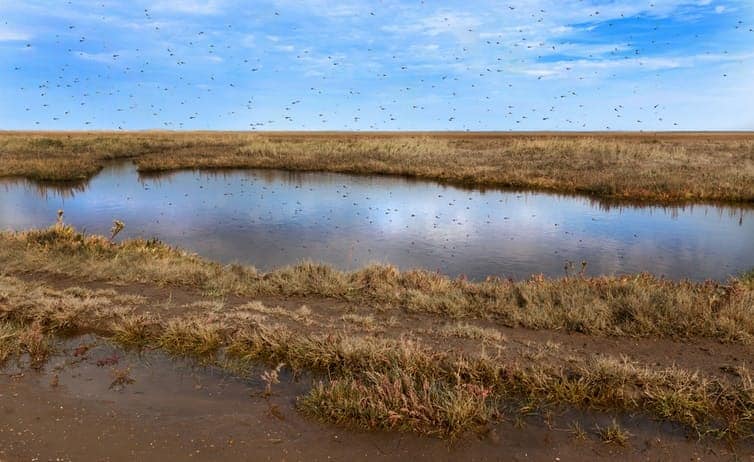

Mosquitoes leave the water and take microplastics with them. Shaun Wilkinson/Shutterstock
Photo: Mosquitoes leave the water and take microplastics with them. Shaun Wilkinson/Shutterstock
There is no doubt that plastic pollution in oceans is a growing worldwide problem. The internet is full of images of seabirds and other marine animals entangled in plastic waste, and animals starve because their guts are blocked with plastic bags.
But the problem goes much deeper than this. Much plastic pollution is in the form of microplastics, tiny fragments less than five micrometres in size and invisible to the naked eye. Our new research shows that these microplastics are even getting into tiny flying insects such as mosquitoes. And this means the plastic can eventually contaminate animals in a more unlikely environment: the air.
Microplastics can come from larger plastic items as they break down, but are also released directly into waste water in their millions in the form of tiny beads found in many cosmetic products including face wash and toothpaste (though these are now banned in many countries).
Many tiny animals can’t tell the difference between their food and microplastics so end up eating them. Once inside an animal, the plastic can transfer via the food chain into fish and other creatures and eventually become a potential health problem for humans.
By studying mosquitoes, we have found a previously unknown way for plastic to pollute the environment and contaminate the food chain. Our new paper, published in Biology Letters, shows for the first time that microplastics can be kept inside a water-dwelling animal as they grow from one life stage to another.
Although most microplastic research has focused on the sea, plastic pollution is also a serious problem in freshwater, including rivers and lakes. Much of the freshwater research has concentrated on animals that live in the water throughout their life. But freshwater insects such as mosquitoes start their lives (as eggs) in water and, after several stages, eventually fly away when they grow up.
It occurred to us that aquatic insects might carry plastics out of the water if they were able to keep the plastics in their body through their development. We tested this possibility by feeding microplastics to mosquito larvae in a laboratory setting. We fed the aquatic young in their third larvae stage food with or without microplastic beads.
We then took samples of the animals when […]
Full article: Microplastics are getting into mosquitoes and contaminating new food chains
Microplastics in our mussels: the sea is feeding human garbage back to us
Microplastics found in more than 90% of bottled water, study says
Proving Terrible For the Marine Life: Microplastics
Microplastic contamination: Plastic fibres found in tap water around the world
Clean water is essential for life, yet millions of Americans unknowingly consume contaminants through their…
Human brains contain higher concentrations of microplastics than other organs, according to a new study, and the…
From the Office of the Governor: In anticipation of a multi-day, significant atmospheric river in Northern California,…
From Governor Newsom: Scientists, water managers, state leaders, and experts throughout the state are calling…
Photo: A harmful algal bloom in Milford Lake, Kansas, made the water appear bright green.…
An expanded plastic foam coffee cup is at a donut shop in Monterey Park, California.…